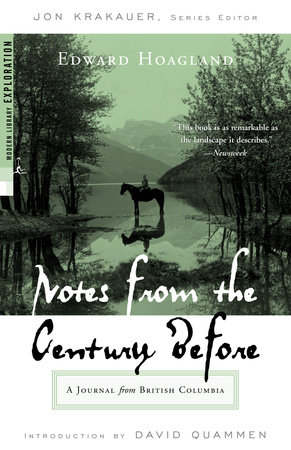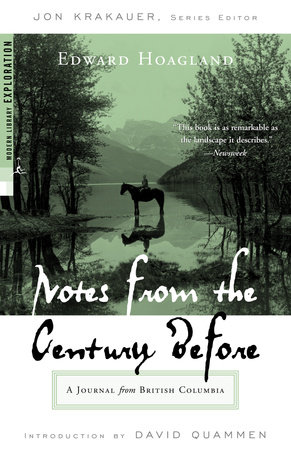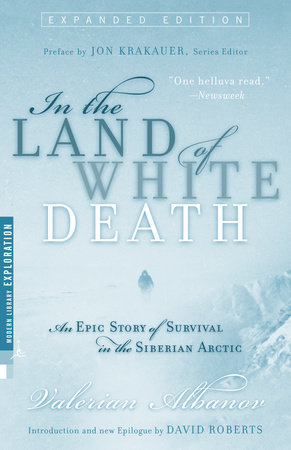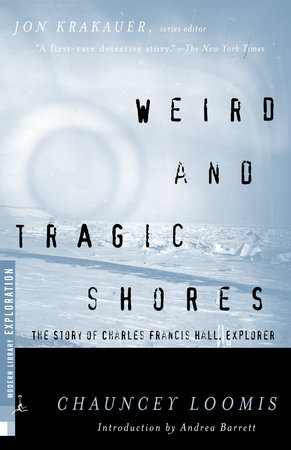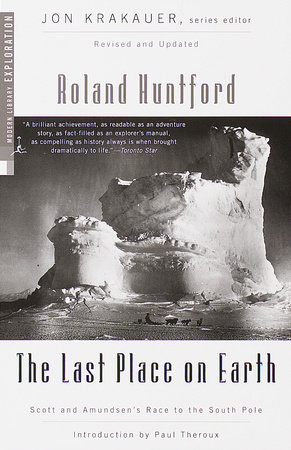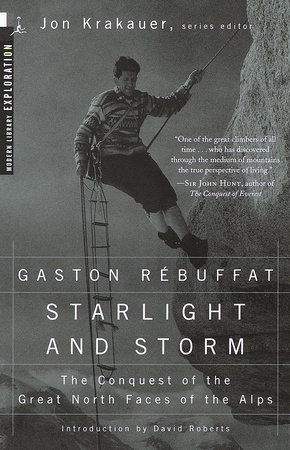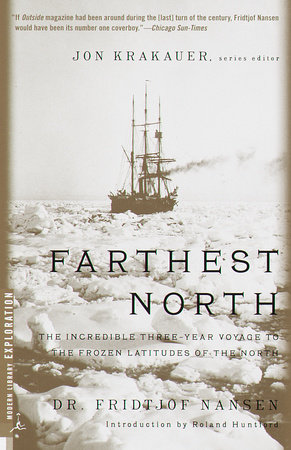Excerpt
Notes from The Century Before
From the Introduction by David Quammen
The century before is now the century before that, and Edward Hoagland’s first nonfiction book is more lively and valuable than ever, thirty-three years after its first publication. Why? When you’ve read it you’ll know, in four or five different dimensions, but for the meantime here’s a provisional, simplistic answer: because it’s filled with human character, lost stories found, the cruel but mesmerizing spectacle of time, and one extraordinarily musical voice, the author’s.
Notes from the Century Before is also cram-packed with landscape but, for all the gloriousness of northwestern British Columbia (at least as it was in 1966, not to mention earlier), landscape is not quite the point. Although Hoagland is happy to call himself “a rhapsodist,” this is something other than a wide-angle rhapsody on mountains and rivers and muskeg and alder thickets and bears. The landscape that Hoagland explores, around the headwaters of the Stikine and Skeena rivers and along the Telegraph Trail, an obscure paisley-patterned region of short, curling valleys and moderate peaks just south of the Yukon and west of the Rockies, is seen mainly as a template to which people have shaped themselves, like limpets and barnacles plastered upon surf-scoured rocks, riding out the bashing high tides and the desiccating lows. The scenery is great but the real rhapsodizing-conveyed indirectly, through descriptive attention-is on the wonderful variousness of human enterprise, perversity, and grit. “There was a murderer named Shorty on the river, who used to shoot people from ambush, or entice them into his boat and tip them overboard in the rapids,” Hoagland reports, apropos of nothing except his own zestful curiosity about the who, what, where, when, and how of his chosen place. Shorty later did time for stealing airplane fuel with a siphon. “He came out of jail a chastened man, a respectable citizen, trained in the tailor’s trade,” is the end of that tale, and if you ask What’s the point?, then you’ve already missed it. Slow down; park your teleology and proceed on foot. Think of a gravel bar along your favorite river, of which every polished ovoid stone is worth picking up and handling for a closer look. Human lives, human faces are the stones here. Hoagland’s language is the polish. Pile them all into a shapely riparian berm-that’s the landscape at issue, a social landscape as well as a geographical one.
It was the lure of fur trapping, the support of the Hudson’s Bay Company, and then the notion of an overland telegraph line linking New York to London by way of Russia, Alaska, and intermountain B.C. that brought white people into this region, where they jostled themselves in among the Tahltan and Tsimshian natives. It was the big Klondike gold rush of 1898 that turned the Stikine into a highway for would-be prospectors headed north, some of whom passed on through, some of whom got sidetracked and stayed. The town of Telegraph Creek grew, shrank, and lingered, while the drainages of the surrounding region came to harbor a sparse sprinkling of homesteaders, dog mushers, part-time sluice miners, surveyors, trading-post managers, outfitters, bush pilots, subsistence fishermen, moonshiners, scroungers, fixers, tinkers, and other freelance survivalists of the nondogmatic type. Many of them died young or disappeared. The toughest and luckiest lived to get old with their recollections of how it had been before mining-company helicopters and the Alaska Highway (many miles eastward beyond a maze of ridges, but its presence felt) began bringing in change at a distinctly different pace. Those people had “opened” the territory, insofar as it was open, though mainly, blessedly, it wasn’t. Hoagland’s act of exploration, which came decades later, was in its way almost as heedlessly ambitious: He went to open the people.
For Hoagland it began in June 1966, when he left New York amid a taxi strike and arrived in Telegraph Creek by riverboat and then single-engine floatplane. He was just thirty-three himself, same age as his book is now. He had done Harvard, done a marriage, done three novels and a diverse selection of arduous jobs, but he had never done a book of nonfiction narrative. He made two important choices. “I decided to do my writing by means of a journal, since everybody I talked to would have his own journal. I’d see journals right and left.” And he decided that the “everybody” to whom he talked would primarily be the old-timers, the codgers from the wild, hard, bygone days, the tribal elders (both white and Indian) who had seasoned into a firm, pungent durability, like well-peppered caribou jerky. He wanted old stories, but new old stories, “stories which hadn’t worn threadbare with handling,” Hoagland explains. “I would be talking to the doers themselves, the men whom no one pays any attention to until they are dead, who give the mountains their names and who pick the passes that become the freeways.” He spent just over two months, a short period of brisk peregrinations, polite prying, herculean listening, and sedulous observation during which his total intake was boggling in its richness, abundance, and percipience. You could exhaust yourself, as you read this book, by trying to imagine how many efforts of memory, how many afternoons of feverish note scribbling, how many late evenings of tired but inspired journal writing it cost its author. My advice is, don’t think about that. Simply read as though you’re beside him there-on the boat, in the plane, at the kitchen table-as this prodigious journey of inquisitiveness unfolds.
Savor the people he savors. In some cases they’re natural storytellers and in some cases they’re shy as oysters, but Hoagland himself is such a fervid listener, such a ravenous watcher, that in every case they surrender something.
Enjoy the portraits he sketches with such scratchy, pen-point conviction. There’s Alec McPhee of Telegraph Creek, an ebullient Scotsman with yellow-silver hair, blue eyes, and a red toothless mouth, who, when he speaks, “shakes his head and his whole body shivers delightedly, because everything that he finds to say amazes and amuses him.”
Besides being the town’s gravedigger, McPhee was responsible for dynamiting snags out of the river. “So he’s a fortunate man, he says, never to have blown himself up, or to have caught a fever from a corpse.” There’s Skook Davidson, eighty-seven, who came into the Kechika valley as horse packer for the early surveyors, and chose to remain, surrounded only by his own feral horses and the wolves that he found to be congenial enough neighbors.
Davidson is “a cranky old man, crippled up with arthritis, cussing into his radio, who gives a report on his wolves instead of his weather, and throws the cork into the creek when he opens a bottle of whiskey so there won’t be a way of stopping the fun.” There’s Walter Sweet, ninety-one, who came up during the first summer of the Klondike rush and stopped off, working claims, fishing commercially, spending money when he had it. Sweet’s chest and back are now “swollen from age. He has a lengthened face, sharp jughandle ears, big hands, and he talks in a heavy, hard-breathing manner. You get a sense of the glamorless labor it’s been, digging in streambeds for a lifetime.” And yet, when a bee flies into his cabin, Sweet carefully catches it in a towel to release outside. “They always go north,” he says.
Whatever guided and drew the bees northward was no more strong and unfathomable, finally, than whatever guided and drew men like Alec McPhee, Skook Davidson, and Walter Sweet to this piece of country.
Whether he’s debriefing the gray-beards, visiting with folks his own age, or merely making his way between dots on the map, Hoagland remains alert to knobby details that say something about the fit among landscape, people, and other animals. Grilled halibut cheeks are served for breakfast at a cafe in Wrangell, at the Stikine’s mouth, but the counterman’s cat accepts nothing but jumbo shrimp. Coyotes were unknown in the upper Iskut valley until they came in as camp followers to the pack trains; now they’re as common as wolves, though they struggle more in heavy snow. Foxes, being “high-strung, susceptible animals,” freeze to death quickly when immobilized by a leg-hold trap. A mustached young man near Eddontenajon Lake is fire-drying trout, slabs of red meat, and the severed head of a moose while Hoagland chats him up, the moose head rotating slowly at the end of a twisted wire. In a novel, the slow-roasting moose head would be a heavy symbol. In this book, in this place, it’s something weightier and less facile: a moose head. It will feed the man’s family for a meal or two.


